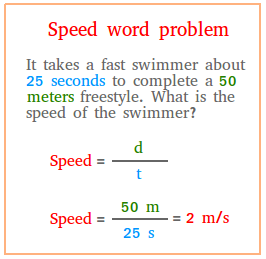Speed word problems
The speed word problems to follow don't have complicated math equations at all. Instead, the focus is on understanding how to apply the concept of speed, distance, and time.
Interesting speed word problems
Problem #1: Calculate the average speed of a lion that runs 45 meters in 5 seconds . What could be some possible instantaneous speeds?
Solution: The formula to get the average speed is
The total distance is 45 meters, so d = 45 meters.
It took the lion 5 seconds to reach a distance of 45 meters.
The total time is 5 seconds, so t = 5.
Just plug these into the formula.
d = 9 meters per second.
You could also write d = 9 m/s.
Some possible instantaneous speed for the lion could be the followings:
13 meters in 1 second v = 13 m/s
9 meters in 1 second v = 9 m/s
10 meters in 1 second v = 10 m/s
8 meters in 1 second v = 8 m/s
5 meters in 1 second v = 5 m/s
As you can see the total distance is 13 + 9 + 10 + 8 + 5 = 45
and the total time is 1 + 1 + 1 + 1 + 1 = 5
Challenging speed word problems
Problem #2: How far is a house in New York if it takes you 5 hours to get there and your average speed is 35 miles per half hour?
First, notice that in the problem we said average speed instead of just speed. It is because you did not just do 35 miles per hour during the entire trip. Your speed changed from times to times, but the average comes to 35 miles per hour.
Second, it is convenient to convert miles per half hour to miles per hour.
35 miles per half hour is 70 miles per hour.
Lastly, convert the formula from speed to distance.
By the same fashion,
Now, we have the speed and the time, we can get the distance.
d = speed × td = 70 × 5
d = 350 miles
Problem #3: Your turn!
How far is a house in Florida if it takes you 4 hours to get there and your instantaneous speeds were 70 miles per hour, 50 miles per hour, 60 miles per hour, 10 miles per hour, and 0 miles per hour?
Take a look also at the speed word problem below
